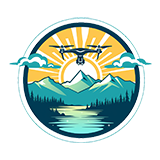Cold weather conditions
Flying drones in winter can deliver stunning images, but there are some important safety precautions to make the experience safer and more enjoyable. In this article, we present five essential tips for flying your drone in the snow.
Let the drone acclimatize
The drone should acclimatize to the outside temperatures before you fly. The body of the drone should adjust to the ambient temperature to prevent snow from melting and water from accumulating, which can cause problems. The charging capacity of the batteries is not affected; they must be treated separately.
Keep the batteries warm
LIPO batteries work inefficiently at cold temperatures. They should therefore be kept warm. There are different methods to keep the batteries warm, e.g: Storing in the car in a warm place. Use portable heating solutions or hand warmers. Keep batteries in a trouser pocket, close to your body. Important: As soon as you fly, the battery will get warm through use, but it is crucial to keep it warm before the flight.
Translated with DeepL.com (free version)
Wear good gloves
The cold can be uncomfortable when holding the controller. Invest in good quality gloves that: Removable fingertips so you can grip the controller sticks well. Are touchscreen-compatible so that you can control your smartphone or tablet. An alternative would be large transmitter coats, but these can be cumbersome.
Do not take off and land directly on the ground
Snow can be whirled up by the propellers, which can contaminate the drone's camera and sensors. To avoid this, you should: Take off and land the drone by hand. Use a take-off and landing plate to create a clean surface. Alternatively, use a backpack as a base to place the drone on.
Keeping the camera clean during the flight
If you are flying in snow, snow can stick to the front of the camera and affect the recordings. To prevent this: Fly backwards when the snow hits you to avoid getting snow on the lens, or fly sideways in relation to the snowfall. Using these techniques, you can get clear, high-quality shots even in difficult weather. [1]
Frost
Special care should be taken on days with high humidity or fog in winter. If the temperature near the ground drops below freezing point, ice can form directly on the drone. Fine water droplets wet the drone and freeze immediately under unfavorable conditions.
A serious problem arises when ice forms on the propellers. This changes their shape, resulting in a loss of lift. It is particularly dangerous that not all propellers have to ice up evenly. To a certain extent, the flight controller can try to compensate for the loss of thrust by turning the affected propellers faster. However, if icing occurs suddenly, a crash is almost unavoidable.
For this reason, you should avoid flying into a fog bank in winter when temperatures are below zero - no matter how tempting the prospect of spectacular shots may be.[2]
| Tipp |
|---|
| Some users recommend spraying Glycerol onto the propellers. This makes sense from a physical point of view, but has not yet been verified |
Betriebstemperatur
Known by the manufacturer:
| Drone | Operating temperature |
|---|---|
| Antigravity A1 | |
| DJI Air 3 | 0 °C bis 40 °C |
| DJI Air 3s | −10 °C bis 40 °C |
| DJI Air2s | 0 °C bis 40 °C |
| DJI Avata | −10 °C bis 40 °C |
| DJI Avata 2 | −10 °C bis 40 °C |
| DJI FPV | 0 °C bis 40 °C |
| DJI Flip | −10 °C bis 40 °C |
| DJI Inspire 3 | −20 °C bis 50°C |
| DJI Matrice 4 | −10 °C bis 40 °C |
| DJI Mavic 3 Classic | −10 °C bis 40 °C |
| DJI Mavic 3 Pro | −10 °C bis 40 °C |
| DJI Mavic 4 Pro | −10 °C bis 40 °C |
| DJI Mini 2 SE | 0 °C bis 40 °C |
| DJI Mini 3 Pro | 0 bis +40 °C |
| DJI Mini 4 Pro | −10 °C bis 40 °C |
| DJI Mini 5 Pro | −10 °C bis 40 °C |
| DJI Neo | −10 °C bis 40 °C |
| DJI Neo 2 | −10 °C bis 40 °C |
| Maginon QC-120 GPS | 0 °C bis 40 °C |
| Maginon QC-710SE WIFI | 10 °C bis 40 °C |
| Maginon QC-720SE WiFi | 10 °C bis 35 °C |
| Maginon QC-90 GPS | 0 °C bis 40 °C |
| Potensic Atom | 0 °C - 40 °C |
| Potensic Atom 2 | 0 °C - 40 °C |
| Potensic Atom SE | 0 °C - 40 °C |
